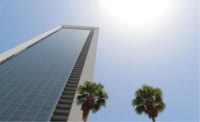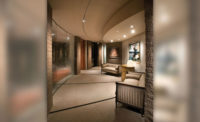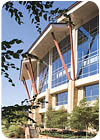
The 400,000-square-foot Lowe's Corporate Headquarters in Mooresville, NC, features a variety of sandstone, Bluestone and fieldstone as exterior design elements. Harvest Gold sandstone was selected as an exterior finish to the building to provide contrast to the glass panels. Architect: Calloway, Johnson, Moore & West, Winston-Salem, NC;Landscape Architect: LandDesign, Southern Pines, NC;
Stone Supplier: Luck Stone Corp., Richmond, VA (Harvest Gold sandstone); Masonry Contractor: Pyramid Masonry Contractors, Inc., Charlotte, NC (Harvest Gold sandstone); Landscape Contractor: Valley Crest Companies, Calabasas, CA (Pennsylvania Bluestone, Eagle Ridge Fieldstone)
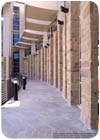
In order to integrate the building and the landscape, Eagle Ridge fieldstone was selected for the site walls because of its rough characteristics, and Pennsylvania Bluestone was used on walkways for its durability.
Scott Lahr, AIA, LEED AP, a principal architect at Calloway, Johnson, Moore & West of Winston-Salem, NC, finds that he is often working with stone as an exterior finish. “I think that designers and clients choose stone materials for both the rich aesthetics that it can achieve as well as the durability and longevity it provides,†he said. Also, these materials can offer a wide variety of colors and textures that other products such as glass, brick and concrete cannot create. Random-sized stone pieces with a rough-cut or hand-chiseled finish can develop a more natural and rustic appearance, while materials such as granite and marble, which are often polished, tend to have a smoother look and feel.
“I think that the primary factors when selecting stone materials are aesthetic ones of color and texture,†said Lahr. “There is such a great variety of options within the stone materials that an incredible variation of looks can be achieved. However, the functional characteristics of durability and maintainability are also important to consider.â€
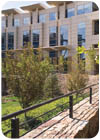
According to Scott Lahr, a principal architect with Calloway, Johnson, Moore & West, “the use of stone on both the interior and exterior fostered the goals for a more natural and relaxed work environment in contrast to typical office environments.â€
A Unique Corporate Setting
For the recent design of the 400,000-square-foot Lowe's Corporate Headquarters in Mooresville, NC, the design team of Calloway, Johnson, Moore & West incorporated sandstone, Bluestone and fieldstone into the exterior design. The materials were selected to meet the client's request that the character of the building be timeless and blend with its 157-acre wooded valley surroundings, as well as to achieve the goal of setting the building apart from competing work environments, according to Lahr.To meet the desired aesthetic, the architects selected a variety of natural stones to be used as exterior cladding on the building, as well as for columns and paving. Together, these materials create a welcoming, relaxing atmosphere for the large corporate office building. Harvest Gold sandstone - from Luck Stone Corp. of Richmond, VA - was used on the exterior portion of the building to contrast the glass panels. The material was used in an ashlar pattern in varying-size pieces, including 5-, 10 1/2- and 16-inch rises.
Next to the building are several walkways and terraces - used primarily for outdoor dining and social events - which feature Pennsylvania Bluestone. In addition, site walls built of Eagle Ridge fieldstone are found throughout the property encompassing the building.
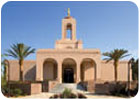
Over 31,000 square feet of Salisbury Pink granite was used on the exterior of the Newport Beach Temple in Newport Beach, CA. Architect: Lloyd E. Platt Associates, Holladay, UT; Contractor: Jacobsen Construction, Salt Lake City, UT; Stone Quarrier: Rock of Ages Corp., Barre, VT; Stone Fabricator: Bestview International, Wood Dale, IL (Salisbury Pink granite); Campolonghi Italia, S.r.l, Massa Italy; Stone Installer: KEPCO+, Salt Lake City, UT
Bob Koontz, RLA, of LandDesign in Southern Pines, NC, was responsible for integrating stone into the landscape design, and said it was integral to the overall project. “We chose fieldstone for the site walls due to its rough characteristics and very natural characteristics,†he said. “We wanted the site walls to blend with the surroundings and to provide a contrast to the more refined stone used on the building.â€
Additionally, Koontz said that the Bluestone was selected for the pavers because of its durability, and because they wanted to use a natural material, rather than a manufactured material like brick.
“I think exterior stone is becoming more common because of the availability,†said Koontz. “The prices of manmade products such as brick and concrete have increased to a point where stone is more competitive now, and people are selecting it because it provides better quality.†The project has been well received and utilized by the corporation and its employees, according to Lahr.
A Stone Haven
The exterior design of the Newport Beach Temple in Newport Beach, CA, also utilized natural stone - featuring more than 31,000 square feet of pink granite, which helps blend the building with its environment, both in color and in style.“The client wanted something of high quality that would integrate into the community well and have the longevity of a stone product,†said Allen Erekson, project architect with Lloyd E. Platt & Associates of Holladay, UT.
Salisbury Pink granite was ultimately selected at the client's request to change the color of the building from off-white to an earth-tone shade of seashell. “The color of the material fit into the surrounding community and was well received by the leaders of the community and the client,†said Erekson. The material was quarried in North Carolina by Rock of Ages and fabricated by Bestview International of Wood Dale, IL, and Campolonghi Italia S.r.l. of Massa, Italy.
The veneer of the building incorporated three different finishes, providing visual interest. The stones forming the base of the building and the archways are polished, the flat veneer is flamed, and the frieze and medallion stones are honed.
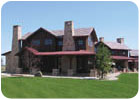
Designed to be a part of a prestigious golf course community located near Vail and Aspen ski areas in Colorado, Terra Verde Architects selected Chilton Rustic Wisconsin limestone - from Buechel Stone Corp. - for the exterior of this residence. Architect: Terra Verde Architects, Boulder, CO; Stone Supplier: Buechel Stone Corp., Fond Du Lac, WI
Other hand-carved details include the arched window surrounds, entrance arches and four half spheres, which were the heaviest pieces fabricated for the project - weighing a total of 1,400 pounds each. A total of 5,623 pieces of Salisbury Pink granite was used on the temple.
Furthermore, the site work and paving feature a combination of flame-finished Royal Peach granite and Royal Rose granite, both quarried in China. The site walls were fabricated from polished Royal Rose granite, and the benches were fabricated from polished Royal Peach granite.
According to Erekson, stone was the only consideration because of its longevity, and the reaction to the project has been very positive. Construction on the temple began in February of 2004 and was completed in June 2005.
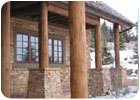
Project Architect Mark Queripel described the Chilton Rustic Wisconsin limestone as being very similar to Colorado Buff sandstone, with shades of red, brown and beige throughout. The architects liked the material because of its dry stack look, and simple yet high-quality installation.
Adding A Quality Finish
Natural stone is also being employed to bring an elegant component to residential homes. Colorado-based Terra Verde Architects often uses stone as an exterior finish for projects, many of which are high-end residences. For the recent design of two homes in the area, Chilton Rustic Wisconsin limestone - from Buechel Stone Corp. - was selected to add a high-quality level to the homes.Both residences were designed to be a part of a prestigious golf course community located near the Vail and Aspen ski areas in Colorado. According to Mark Queripel of Terra Verde Architects, the goal was to add a quality finish level to the residences, and to create a luxury retreat-like atmosphere. Queripel described the Chilton Rustic Wisconsin limestone as being very similar to Colorado Buff sandstone, with shades of red, brown and beige throughout.
For one of the residences, 40% of the exterior is comprised of the limestone material. “The stone was used for three primary fireplace chimneys, and for a wainscoting around a large portion of the home,†said the architect. “It was also used as a full-height walk-out level, for the bottom 10 feet of the house.â€
The material was selected because the architects wanted to design the veneer in a dry stack look. “Buechel Stone Corp. offered a unique veneer thickness cut stone at the time, which was only 2 to 21/2 inches thick, and they cut the corners to look like full thick pieces of stone as well,†said Queripel, adding that everyone involved with both projects were extremely happy with the material. “I found the installation of this particular material to be nice and simple.
“People really like stone,†he continued. “We have sophisticated buyers in this area of Colorado, and they wanted real stone.â€
